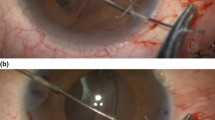Abstract
Purpose
To disclose histological advantages of intrascleral fixation of intraocular lens haptics, in comparison with scleral suture fixation, in a study with rabbits.
Methods
Ten white rabbits, 10 weeks of age, were used in this experimental histopathological study. After unilateral lensectomy and anterior vitrectomy, an intraocular lens haptic was inserted into one eye of each rabbit. Intrascleral fixation was performed in five rabbits, whereas scleral suture fixation was performed in the others. At postoperative 1 week, the globe was enucleated in two rabbits in each group; at postoperative 8 weeks, the globe was enucleated in the remaining three rabbits in each group. Sections of the sclera around haptics and sutures were evaluated with haematoxylin and eosin and immunohistochemical staining methods. We assessed severity of inflammation on histopathological photos, taken near the haptic or suture in the sclera, by counting white blood cells. The Mann-Whitney U test was performed to analyse differences in the severity of inflammation between the groups.
Results
Samples in the intrascleral fixation group demonstrated reduced irregularity of collagen fibres; reduced infiltration of fibroblasts, giant cells, lymphocytes, neovascular cells, neutrophils and eosinophils and weaker staining for fibronectin (indicating tissue repair) and heat shock protein 70 (indicating cell damage). In addition, reduced white blood cell infiltration was observed in the intrascleral fixation samples at 8 weeks in both shallow sclera (p = 0.001) and deep sclera (p = 0.002).
Conclusions
Histological analysis showed that intrascleral fixation caused fewer inflammatory changes than scleral suture fixation, with reduced fibroblast migration and production of cytotoxic factors.







Similar content being viewed by others
References
Gabor SG, Pavlidis MM (2007) Sutureless intrascleral posterior chamber intraocular lens fixation. J Cataract Refract Surg 33:1851–1854
Agarwal A, Kumar DA, Jacob S, Baid C, Agarwal A, Srinivasan S (2008) Fibrin glue-assisted sutureless posterior chamber intraocular lens implantation in eyes with deficient posterior capsules. J Cataract Refract Surg 34:1433–1438
Kumar DA, Agarwal A, Packiyalakshmi S, Jacob S, Agarwal A (2013) Complications and visual outcomes after glued foldable intraocular lens implantation in eyes with inadequate capsules. J Cataract Refract Surg 39:1211–1218
Ganekal S, Venkataratnam S, Dorairaj S, Jhanji V (2012) Comparative evaluation of suture-assisted and fibrin glue-assisted scleral fixated intraocular lens implantation. J Refract Surg 28:249–252
Matsui Y, Matsubara H, Hanemoto T, Kondo M (2015) Exposure of haptic of posterior chamber intraocular lens after sutureless intrascleral fixation. BMC Ophthalmol 15:104
Glasser DB, Bellor J (1992) Necrotizing scleritis of scleral flaps after transscleral suture fixation of an intraocular lens. Am J Ophthalmol 113:529–532
Lewis JS (1991) Ab externo sulcus fixation. Ophthalmic Surg 22:692–695
Weinacker A, Cheen A, Agrez M, Cone RI, Nishimura S, Wayner E, Pytela R, Sheppard D (1994) Role of integrin αvβ6 in cell attachment to fibronectin: heterologous expression of intact and secreted forms of the receptor. J Biol Chem 269:6940–6948
Craig EA, Weissman JS, Horwich AL (1994) Heat shock proteins and molecular chaperones: mediators of protein conformation and turnover in the cell. Cell 78:365–372
Yamane S, Sato S, Maruyama-Inoue M, Kadonosono K (2017) Flanged intrascleral intraocular lens fixation with double-needle technique. Ophthalmology 124:1136–1142
Izak AM, Werner L, Apple DJ, Macky TA, Trivedi RH, Pandey SK (2002) Loop memory of haptic materials in posterior chamber intraocular lenses. J Cataract Refract Surg 28:1229–1235
Yamanaka A, Nakamae K, Takeuchi M, Momose A, Fukado Y, Oshima K, Goto H (1985) Scanning electron microscope study on the biodegradation of IOL and suturing materials. Trans Ophthalmol Soc UK 104:517–521
Price MO, Price FW Jr, Werner L, Berlie C, Mamalis N (2005) Late dislocation of scleral-sutured posterior chamber intraocular lenses. J Cataract Refract Surg 31:1320–1326
Mukai K, Matsushima H, Gotoh N, Aose M, Satoshi W, Wataru T, Matsui E, Nagata M, Senoo T (2009) Efficacy of ophthalmic nonsteroidal antiinflammatory drugs in suppressing anterior capsule contraction and secondary posterior capsule opacification. J Cataract Refract Surg 35:1614–1618
Acknowledgements
We thank Ryan Chastain-Gross, Ph.D., from Edanz Group (www.edanzediting.com/ac) for editing a draft of this manuscript.
Author information
Authors and Affiliations
Corresponding author
Ethics declarations
Conflicts of interest
The authors declare that they have no conflict of interest.
Ethical approval
All procedures performed in studies involving animals were in accordance with the ethical standards of the institution or practice at which the studies were conducted. This article does not contain any studies with human participants performed by any of the authors.
Additional information
Publisher’s note
Springer Nature remains neutral with regard to jurisdictional claims in published maps and institutional affiliations.
Rights and permissions
About this article
Cite this article
Hanemoto, T., Mukai, K., Matsushima, H. et al. Intrascleral fixation of intraocular lens haptics: histological advantages in a comparison with scleral suture fixation in rabbits. Graefes Arch Clin Exp Ophthalmol 257, 465–472 (2019). https://doi.org/10.1007/s00417-019-04243-z
Received:
Revised:
Accepted:
Published:
Issue Date:
DOI: https://doi.org/10.1007/s00417-019-04243-z




